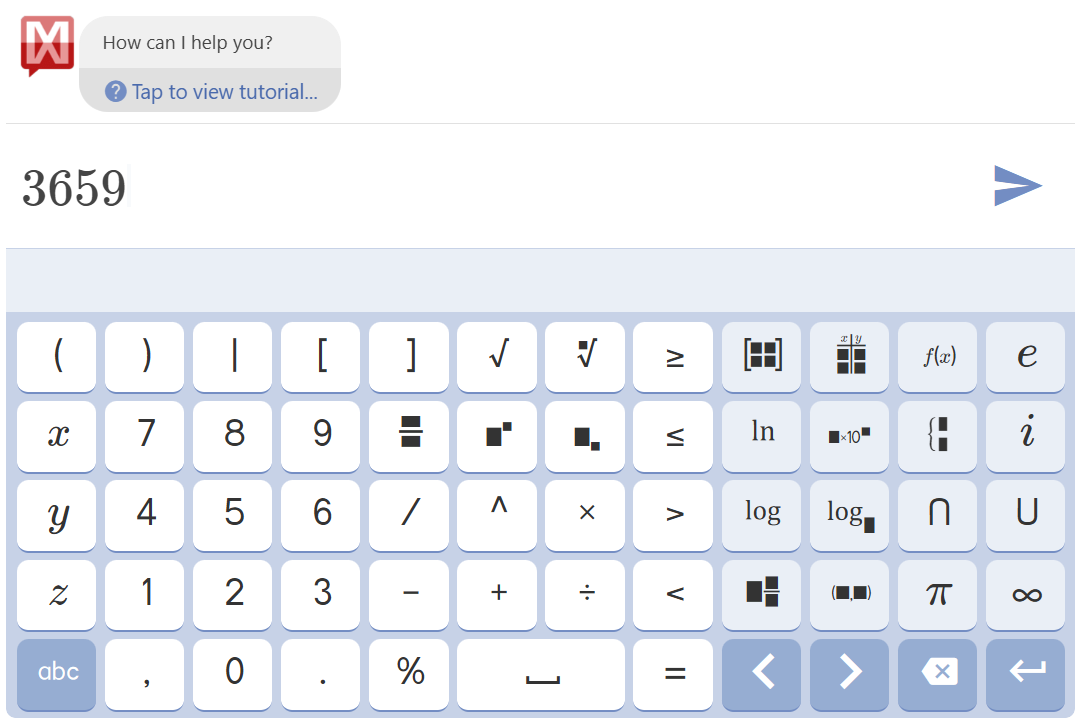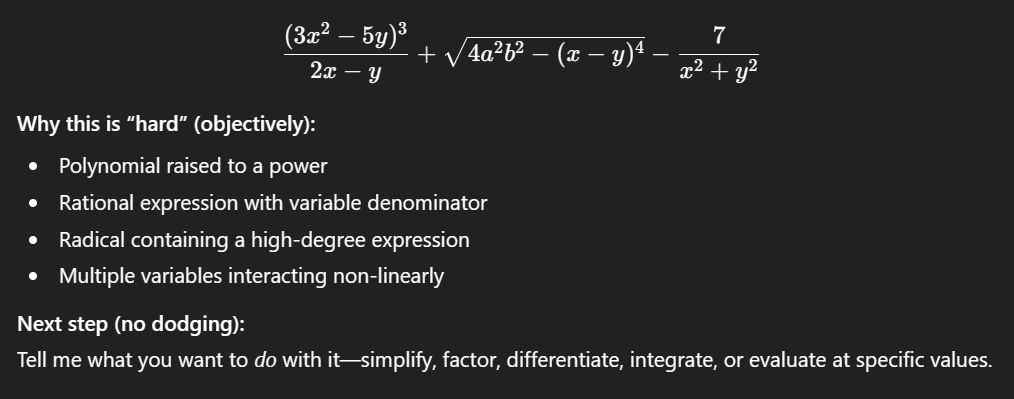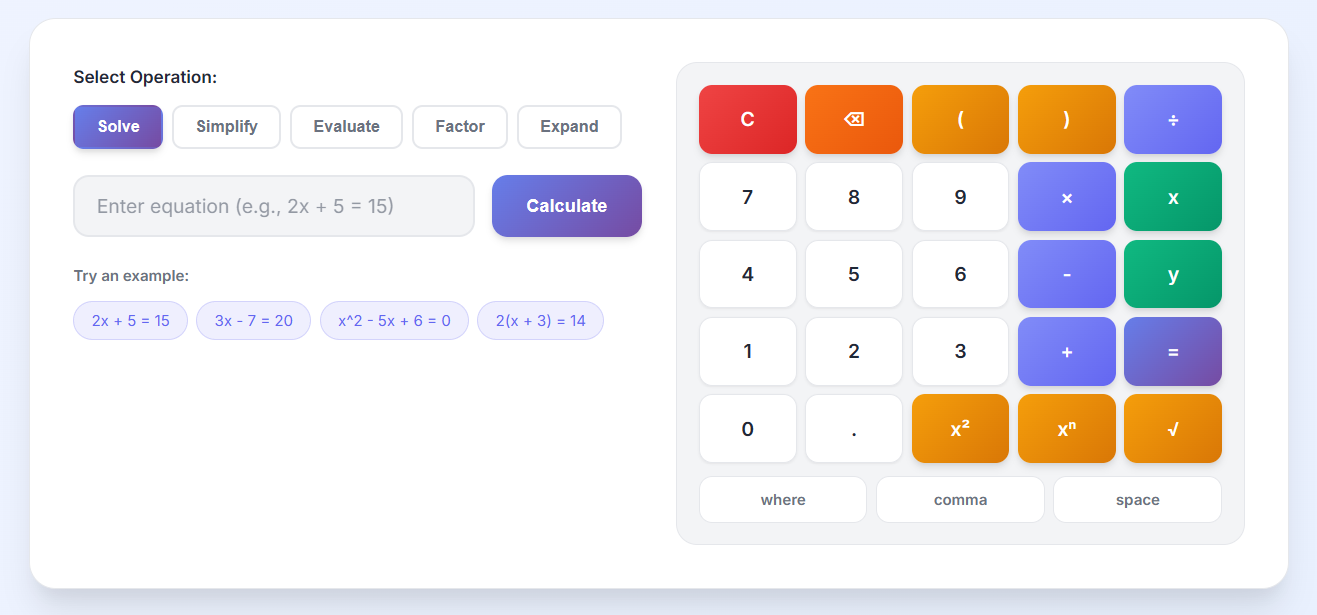Mathway - Your Free Math Problem Solver
Solve complex math problems instantly with Mathway. Get step-by-step solutions for algebra, calculus, trigonometry, and more. Trusted by millions of students and teachers worldwide.
What is Mathway?
Mathway is a revolutionary math problem solver and calculator that helps students, teachers, and professionals solve mathematical equations with ease. Whether you're working on basic algebra or advanced calculus, Mathway provides instant, accurate solutions with detailed step-by-step explanations.
As one of the most popular math solvers available online, Mathway has become an essential tool for anyone looking to understand mathematics better. The platform offers comprehensive solutions for a wide range of mathematical topics, making it the go-to resource for math homework help and learning.
 Mathway
MathwayAlgebra Calculator
Enter your algebra problem below and get instant step-by-step solutions. Our calculator can solve equations, simplify expressions, factor polynomials, and more.
Key Features of Mathway
Comprehensive Math Solver
Mathway solves problems across multiple mathematical disciplines including algebra, geometry, calculus, trigonometry, statistics, and more. No matter what type of math problem you're facing, Mathway can help.
Step-by-Step Solutions
Unlike simple calculators that only provide answers, Mathway shows you exactly how to solve each problem. Every solution includes detailed steps, helping you understand the process and learn from each problem.
Algebra Calculator
The Mathway algebra calculator handles everything from basic linear equations to complex polynomial expressions. Factor, expand, simplify, and solve algebraic equations with ease.
Free to Use
Mathway is completely free to use, making it accessible to students and educators worldwide. No registration required, no hidden fees - just instant math problem solving at your fingertips.
Multiple Input Methods
Enter your math problems using our intuitive interface. Type equations directly, use our virtual keyboard, or input problems in natural language - Mathway understands it all.
Instant Results
Get solutions in seconds. Mathway's powerful computational engine processes your problems instantly, providing accurate results and explanations without delay.

How Mathway Works
Enter Your Problem
Type your math problem into the Mathway calculator. You can enter equations, expressions, or word problems using our user-friendly interface.
Choose the Math Subject
Select the appropriate math subject from Mathway's comprehensive list, including Basic Math, Pre-Algebra, Algebra, Trigonometry, Precalculus, Calculus, Statistics, and more.
Get Step-by-Step Solutions
Mathway instantly provides detailed solutions with step-by-step explanations. Each step is clearly shown, helping you understand how to solve similar problems in the future.
Why Choose Mathway?
Mathway stands out as the premier math problem solver for several reasons. Whether you're a student struggling with homework, a teacher preparing lessons, or a professional needing quick calculations, Mathway offers unmatched value.

- Educational Value: Mathway doesn't just give answers - it teaches you how to solve problems through comprehensive step-by-step solutions. This makes it an excellent learning tool for students at all levels.
- Time-Saving: Solve complex math problems in seconds instead of spending hours working through them manually. Mathway helps you focus on understanding concepts rather than getting stuck on calculations.
- Accuracy Guaranteed: Mathway's advanced algorithms ensure accurate results every time. You can trust Mathway to provide correct solutions for even the most complex mathematical problems.
- Accessibility: Available 24/7 from any device with internet access. Mathway works on computers, tablets, and smartphones, making it convenient for studying anywhere, anytime.
- Wide Range of Topics: From basic arithmetic to advanced calculus, Mathway covers virtually every mathematical topic you'll encounter in your studies or work.
Who Uses Mathway?
Students
Students at all levels use Mathway to check homework, understand difficult concepts, and prepare for exams. Mathway helps students learn by showing the solution process, not just the final answer.
Teachers
Educators use Mathway to verify solutions, create practice problems, and demonstrate problem-solving techniques to their students. Mathway is an invaluable teaching tool.
Parents
Parents helping with homework find Mathway essential for understanding and explaining math concepts to their children. Mathway makes it easy to provide accurate help.
Professionals
Engineers, scientists, and other professionals use Mathway for quick calculations and problem-solving in their work. Mathway's accuracy and speed make it a reliable professional tool.
Math Topics Covered by Mathway
Mathway provides solutions for a comprehensive range of mathematical topics. Here are some of the key areas where Mathway excels:
Basic Math
Arithmetic operations, fractions, decimals, percentages, and more. Try our Mathway calculator for basic math operations.
Pre-Algebra
Integers, factors, exponents, radicals, and basic algebraic concepts
Algebra
Linear equations, quadratic equations, polynomials, factoring, and systems of equations
Trigonometry
Sine, cosine, tangent, identities, and trigonometric equations
Precalculus
Functions, limits, sequences, series, and advanced algebraic concepts
Statistics
Probability, distributions, hypothesis testing, and data analysis
Linear Algebra
Matrices, vectors, determinants, and systems of linear equations
Frequently Asked Questions About Mathway
Is Mathway really free to use?
Yes, Mathway is completely free to use. You can access the basic math problem solver and calculator without any registration or payment. Mathway believes in making quality math education accessible to everyone.
What types of math problems can Mathway solve?
Mathway can solve a wide variety of math problems including algebra, calculus, trigonometry, statistics, geometry, and more. The Mathway calculator handles everything from simple arithmetic to complex calculus problems.
Does Mathway show step-by-step solutions?
Yes, one of Mathway's key features is providing detailed step-by-step solutions. This helps users understand not just the answer, but how to arrive at that answer, making Mathway an excellent learning tool.
Can I use Mathway on my mobile device?
Absolutely! Mathway is fully responsive and works on all devices including smartphones and tablets. You can access Mathway from anywhere with an internet connection.
Is Mathway accurate?
Yes, Mathway uses advanced mathematical algorithms to ensure accuracy. The platform is trusted by millions of users worldwide for its reliable and precise solutions.
How do I get started with Mathway?
Getting started with Mathway is simple - just visit our website, enter your math problem, and get instant solutions. No registration or download required. Mathway is ready to use immediately.
Ready to Solve Your Math Problems with Mathway?
Start using Mathway today and experience the power of instant, accurate math problem solving. Whether you're a student, teacher, or professional, Mathway is here to help you succeed in mathematics.
Visit Mathway at math-tools.com and discover why millions of users trust Mathway for their math problem solving needs.